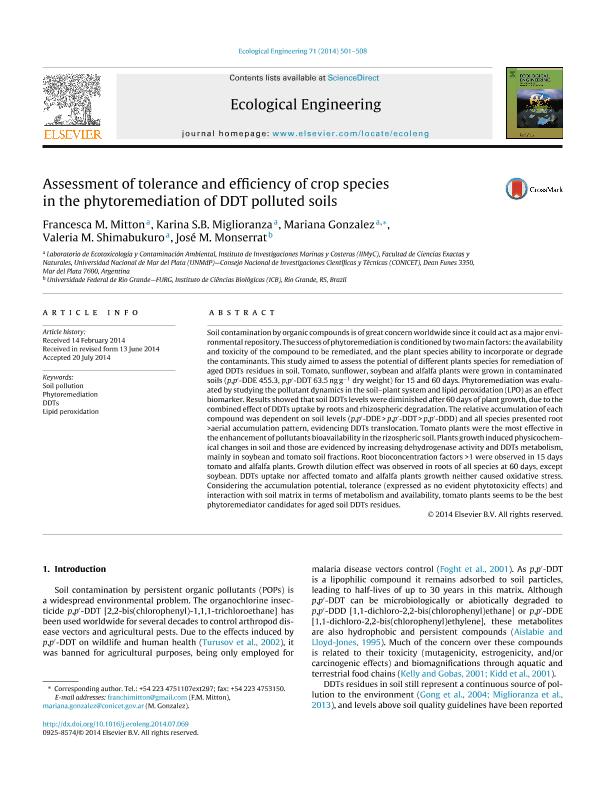Mostrar el registro sencillo del ítem
dc.contributor.author
Mitton, Francesca María

dc.contributor.author
Miglioranza, Karina Silvia Beatriz

dc.contributor.author
Gonzalez, Mariana

dc.contributor.author
Shimabukuro, Valeria Mercedes

dc.contributor.author
Monserrat, José María

dc.date.available
2018-01-29T12:22:57Z
dc.date.issued
2014-07
dc.identifier.citation
Mitton, Francesca María; Miglioranza, Karina Silvia Beatriz; Gonzalez, Mariana; Shimabukuro, Valeria Mercedes; Monserrat, José María; Assessment of tolerance and efficiency of crop species in the phytoremediation of DDT polluted soils; Elsevier Science; Ecological Engineering; 71; 7-2014; 501-508
dc.identifier.issn
0925-8574
dc.identifier.uri
http://hdl.handle.net/11336/34818
dc.description.abstract
Soil contamination by organic compounds is of great concern worldwide since it could act as a major environmental repository. The success of phytoremediation is conditioned by two main factors: the availability and toxicity of the compound to be remediated, and the plant species ability to incorporate or degrade the contaminants. This study aimed to assess the potential of different plants species for remediation of aged DDTs residues in soil. Tomato, sunflower, soybean and alfalfa plants were grown in contaminated soils (p,p′-DDE 455.3, p,p′-DDT 63.5 ng g−1 dry weight) for 15 and 60 days. Phytoremediation was evaluated by studying the pollutant dynamics in the soil–plant system and lipid peroxidation (LPO) as an effect biomarker. Results showed that soil DDTs levels were diminished after 60 days of plant growth, due to the combined effect of DDTs uptake by roots and rhizospheric degradation. The relative accumulation of each compound was dependent on soil levels (p,p′-DDE > p,p′-DDT > p,p′-DDD) and all species presented root >aerial accumulation pattern, evidencing DDTs translocation. Tomato plants were the most effective in the enhancement of pollutants bioavailability in the rizospheric soil. Plants growth induced physicochemical changes in soil and those are evidenced by increasing dehydrogenase activity and DDTs metabolism, mainly in soybean and tomato soil fractions. Root bioconcentration factors >1 were observed in 15 days tomato and alfalfa plants. Growth dilution effect was observed in roots of all species at 60 days, except soybean. DDTs uptake nor affected tomato and alfalfa plants growth neither caused oxidative stress. Considering the accumulation potential, tolerance (expressed as no evident phytotoxicity effects) and interaction with soil matrix in terms of metabolism and availability, tomato plants seems to be the best phytoremediator candidates for aged soil DDTs residues.
dc.format
application/pdf
dc.language.iso
eng
dc.publisher
Elsevier Science

dc.rights
info:eu-repo/semantics/openAccess
dc.rights.uri
https://creativecommons.org/licenses/by-nc-sa/2.5/ar/
dc.subject
Soil Pollution
dc.subject
Phytoremediation
dc.subject
Ddts
dc.subject
Lipid Peroxidation
dc.subject.classification
Meteorología y Ciencias Atmosféricas

dc.subject.classification
Ciencias de la Tierra y relacionadas con el Medio Ambiente

dc.subject.classification
CIENCIAS NATURALES Y EXACTAS

dc.title
Assessment of tolerance and efficiency of crop species in the phytoremediation of DDT polluted soils
dc.type
info:eu-repo/semantics/article
dc.type
info:ar-repo/semantics/artículo
dc.type
info:eu-repo/semantics/publishedVersion
dc.date.updated
2018-01-26T18:58:06Z
dc.journal.volume
71
dc.journal.pagination
501-508
dc.journal.pais
Países Bajos

dc.journal.ciudad
Amsterdam
dc.description.fil
Fil: Mitton, Francesca María. Consejo Nacional de Investigaciones Científicas y Técnicas. Centro Científico Tecnológico Conicet - Mar del Plata. Instituto de Investigaciones Marinas y Costeras. Universidad Nacional de Mar del Plata. Facultad de Ciencia Exactas y Naturales. Instituto de Investigaciones Marinas y Costeras; Argentina
dc.description.fil
Fil: Miglioranza, Karina Silvia Beatriz. Consejo Nacional de Investigaciones Científicas y Técnicas. Centro Científico Tecnológico Conicet - Mar del Plata. Instituto de Investigaciones Marinas y Costeras. Universidad Nacional de Mar del Plata. Facultad de Ciencia Exactas y Naturales. Instituto de Investigaciones Marinas y Costeras; Argentina
dc.description.fil
Fil: Gonzalez, Mariana. Consejo Nacional de Investigaciones Científicas y Técnicas. Centro Científico Tecnológico Conicet - Mar del Plata. Instituto de Investigaciones Marinas y Costeras. Universidad Nacional de Mar del Plata. Facultad de Ciencia Exactas y Naturales. Instituto de Investigaciones Marinas y Costeras; Argentina
dc.description.fil
Fil: Shimabukuro, Valeria Mercedes. Consejo Nacional de Investigaciones Científicas y Técnicas. Centro Científico Tecnológico Conicet - Mar del Plata. Instituto de Investigaciones Marinas y Costeras. Universidad Nacional de Mar del Plata. Facultad de Ciencia Exactas y Naturales. Instituto de Investigaciones Marinas y Costeras; Argentina
dc.description.fil
Fil: Monserrat, José María. Universidade Federal do Rio Grande do Sul; Brasil
dc.journal.title
Ecological Engineering

dc.relation.alternativeid
info:eu-repo/semantics/altIdentifier/doi/http://dx.doi.org/10.1016/j.ecoleng.2014.07.069
dc.relation.alternativeid
info:eu-repo/semantics/altIdentifier/url/https://www.sciencedirect.com/science/article/pii/S0925857414003607
Archivos asociados
